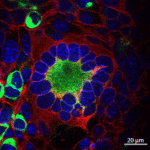Link to Pubmed [PMID] – 23015714
J. Virol. 2012 Dec;86(24):13350-9
Simian foamy viruses (SFVs) are retroviruses that are widespread among nonhuman primates (NHPs). SFVs actively replicate in their oral cavity and can be transmitted to humans after NHP bites, giving rise to a persistent infection even decades after primary infection. Very few data on the genetic structure of such SFVs found in humans are available. In the framework of ongoing studies searching for SFV-infected humans in south Cameroon rainforest villages, we studied 38 SFV-infected hunters whose times of infection had presumably been determined. By long-term cocultures of peripheral blood mononuclear cells with BHK-21 cells, we isolated five new SFV strains and obtained complete genomes of SFV strains from chimpanzee (Pan troglodytes troglodytes; strains BAD327 and AG15), monkey (Cercopithecus nictitans; strain AG16), and gorilla (Gorilla gorilla; strains BAK74 and BAD468). These zoonotic strains share a very high degree of similarity with their NHP counterparts and have a high degree of conservation of the genetic elements important for viral replication. Interestingly, analysis of FV DNA sequences obtained before cultivation revealed variants with deletions in both the U3 region and tas that may correlate with in vivo chronicity in humans. Genomic changes in bet (a premature stop codon) and gag were also observed. To determine if such changes were specific to zoonotic strains, we studied local SFV-infected chimpanzees and found the same genomic changes. Our study reveals that natural polymorphism of SFV strains does exist at both the intersubspecies level (gag, bet) and the intrasubspecies (U3, tas) levels but does not seem to reflect a viral adaptation specific to zoonotic SFV strains.


